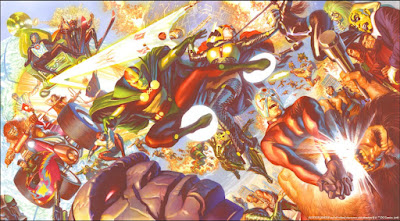 |
| Art by Alex Ross |
A notable trait of the so-called New Gods is that they are arranged in a sort of dualistic polytheism (not unlike the gods of Tekumel in Empire of the Petal Throne). The gods of New Genesis are the "good" gods and those Apokolips are the "evil" gods.
As presented in the comics, the portfolios of the Apokolipsian gods (to the extent they are clear) are modern evils. They are mostly related to concerns of its author in post-World War II West, rather than traditional concerns of ancient or Medieval peoples. They will require some modification. They work better as devils or demons, probably, as Apokolips is pretty much Hell.
Interestingly, the stories that take place on Apokolips regarding the escape of Mister Miracle and friends have an almost gnostic dimension. Darkseid is a Demiurge sort of figure, while the Promethean Himon is the serpent in the stifling, poisonous Garden of Apokolips leading Mister Miracle to freedom.
In contrast, the gods of New Genesis are a bit more straightforward, harkening in many cases to Norse or Greek polytheistic figures. The problem is they just don't always have really clearly portfolios.
Anyway, here's what I've got:
New Genesis:
- Highfather - Patriarchal leader of the gods of New Genesis. God of Wisdom, Diplomacy, and Rulership.
- Lightray - God of light, probably the sun too.
- Orion - God of War; given to berserker rages.
- Mister Miracle - A dying and rising god, probably with a mystery cult.
- Big Barda - Warrior goddess; defector from Apokolips
- Black Racer - Psychopomp and god of Death.
- Lonar - the Wanderer; god of horses and hospitality
- Metron - God of knowledge and travel.
Apokolips:
- Darkseid - Supreme god of evil.
- Kalibak - Monstrous son of Darkseid; god of violence and destruction.
- DeSaad - Lord of torture and cruelty
- Doctor Bedlam - God of Madness
- Female Furies - A (more) evil version of Valkyries
- Glorious Godfrey - God of Lies
- Granny Goodness - The cruel mother; a stealer of children, perhaps a Baba Yaga sort?
- Kanto - God of assassins
- Mantis - Vampiric lord of plagues and pestilence
- Steppenwolf - Dark lord of the hunt

















